Consumer behaviour has always been a critical area of focus for marketers, but the rapid evolution of technology, social trends, and economic factors has made it more complex and dynamic than ever before. As we look ahead to 2026, it is essential for marketers to understand how consumers think, feel, and make purchasing decisions in a world that is increasingly driven by digital transformation, sustainability concerns, and changing social norms. JIMS Delhi, the best B-school in Delhi, plays a key role in equipping future marketing professionals with the knowledge and skills necessary to navigate these shifts in consumer behaviour.
In this article, we will explore the key factors influencing consumer behaviour in 2026, how these factors are reshaping marketing strategies, and the actionable insights marketers can use to engage with their audience more effectively.
The Impact of Technology on Consumer Behaviour
Technology continues to revolutionize every aspect of consumer behaviour, and by 2026, the effects will be even more profound. The rise of artificial intelligence (AI), machine learning, and automation is already enabling personalized experiences at scale. Consumers are more empowered than ever to make informed decisions, and businesses are leveraging technology to cater to their needs in real time.
-
Personalization Through Data Analytics
In 2026, consumers expect highly personalized experiences that are tailored to their preferences, behaviours, and past interactions. With the help of advanced data analytics, AI-driven algorithms can predict consumer preferences and make product recommendations with remarkable accuracy. As a result, marketers will need to invest heavily in customer data platforms (CDPs) to gather, process, and analyse data from various sources such as online browsing behaviour, social media activity, and previous purchases. This data-driven approach allows for hyper-targeted marketing campaigns that resonate with individual consumers, leading to higher engagement and conversion rates.
-
Voice Search and Smart Devices
Voice search and smart home devices are transforming the way consumers search for products and services. By 2026, voice-activated devices like Amazon Echo, Google Nest, and Apple Home Pod will be even more integrated into everyday life, allowing consumers to make purchases, receive recommendations, and interact with brands hands-free. Marketers will need to optimize their content for voice search by focusing on natural language and conversational queries. Understanding how voice search differs from traditional search queries will help businesses adapt their strategies and capture this growing segment of consumers.
-
Virtual and Augmented Reality (VR/AR)
Virtual and augmented reality technologies are becoming increasingly popular for providing immersive consumer experiences. In 2026, the use of VR and AR in marketing will continue to expand, particularly in sectors like retail, real estate, and travel. Brands will use AR to allow consumers to try products virtually before making a purchase. For example, beauty brands will enable customers to “try on” makeup through their smartphones, while furniture companies will allow users to visualize how a piece of furniture would look in their homes. Marketers will need to explore how these immersive technologies can enhance customer engagement and drive conversions.
The Rise of Ethical and Sustainable Consumerism
As we move toward 2026, consumers are becoming increasingly aware of the social, environmental, and ethical impact of their purchasing decisions. This trend is driven by growing concerns over climate change, sustainability, and social responsibility. Ethical consumerism is no longer a niche market but has become a mainstream movement that demands attention from marketers.
-
Sustainability as a Priority
Today’s consumers are more concerned about the sustainability practices of the brands they support. According to various studies, consumers are willing to pay a premium for products and services that are ethically sourced, eco-friendly, and sustainable. By 2026, this trend will only accelerate, with more consumers seeking transparency regarding the sourcing, manufacturing, and lifecycle of products. Marketers will need to demonstrate a genuine commitment to sustainability through eco-friendly packaging, responsible sourcing, and carbon-neutral initiatives. Brands that fail to align with consumer expectations on sustainability may face backlash and reputational damage.
-
Social Responsibility and Corporate Activism
In addition to sustainability, consumers are increasingly looking for brands that take a stand on social and political issues. Brands that are perceived as socially responsible—by supporting causes such as diversity, gender equality, and racial justice—are gaining favor with younger generations, particularly Gen Z. By 2026, consumers will expect brands to go beyond surface-level activism and engage in meaningful actions that drive social change. Marketers should ensure their corporate social responsibility (CSR) initiatives are authentic and aligned with the values of their target audience.
Shifting Demographics and Changing Consumer Preferences
The demographic makeup of consumers is continuously evolving, and this will continue to impact consumer behaviour in 2026. As millennials and Gen Z continue to grow as a purchasing power, their preferences, behaviours, and expectations will shape the future of marketing.
-
Millennials and Gen Z as the Primary Consumers
By 2026, Millennials and Gen Z will make up a larger proportion of the global consumer base. These generations are highly tech-savvy, socially conscious, and value-driven. They are more likely to engage with brands that reflect their values, support inclusivity, and promote environmental sustainability. For marketers, this means understanding their desire for transparency, authenticity, and a personalized experience. Gen Z, in particular, values individuality and self-expression, and they often seek products and brands that align with their personal identity. Marketers will need to create campaigns that resonate with the uniqueness of these generations, focusing on inclusivity, social impact, and creative expression.
-
The Rise of the Digital Nomad and Remote Worker
With the continued rise of remote work and the digital nomad lifestyle, the traditional concept of work and leisure is being redefined. By 2026, this group of professionals will continue to grow, leading to changes in consumer behaviour. Digital nomads tend to prioritize flexibility, experiences over material goods, and value products and services that align with their mobile lifestyle. Marketers targeting this group will need to understand their unique needs, offering solutions that support their lifestyle, such as flexible working tools, co-working spaces, and travel-related products.
-
The Aging Population
As the global population ages, marketers will also need to cater to the needs of older consumers. By 2026, the aging population will be more active, financially stable, and digitally connected than ever before. This shift presents an opportunity for businesses to create products and services that cater to older consumers, from health and wellness products to tech devices that cater to their lifestyle. The key to engaging with this demographic will be personalization, accessibility, and inclusivity in marketing materials.
The Growing Importance of Experience Over Product
As we approach 2026, consumers are increasingly shifting their focus from product ownership to experiences. The experience economy, which prioritizes memorable experiences over material goods, is on the rise, especially among younger consumers.
-
Experiential Marketing
Experiential marketing creates immersive, emotional connections between brands and consumers by providing memorable experiences. Brands are moving beyond traditional advertising and focusing on creating experiences that engage consumers on a personal level. This could include pop-up events, virtual reality experiences, interactive social media campaigns, and personalized product trials. For marketers, it’s essential to understand how to design unique, shareable experiences that resonate with their target audience and encourage loyalty.
-
Brand Experiences in the Digital Age
In the digital age, experiences don’t only take place in physical spaces; they happen online as well. Social media platforms, live streaming, and immersive digital environments offer brands new ways to connect with consumers. Marketers will need to focus on creating interactive, engaging digital experiences that leave a lasting impression, whether through gamified content, live interactions, or personalized online experiences.
The Influence of Social Media and Influencers
By 2026, social media will continue to play a central role in influencing consumer behaviour, with platforms like Instagram, TikTok, and YouTube leading the way. Consumers increasingly rely on social media for recommendations, reviews, and product discoveries, making it essential for brands to have a strong presence.
The Power of Influencer Marketing
Influencers, especially those on platforms like Instagram and TikTok, have the power to shape consumer behaviour in a way that traditional advertising cannot. These influencers have cultivated trust and credibility with their followers, making them powerful advocates for brands. By 2026, influencer marketing will continue to grow, but it will become more authentic and transparent. Marketers will need to focus on partnering with influencers who align with their brand values and resonate with their target audience.
Social Commerce
Social commerce, or the ability to purchase products directly through social media platforms, is expected to grow significantly by 2026. Platforms like Instagram and Facebook have already integrated e-commerce features, and by 2026, these platforms will be more deeply integrated into the consumer shopping journey. Marketers will need to create seamless shopping experiences within social media environments, making it easier for consumers to discover and purchase products directly.
Conclusion
Understanding consumer behaviour in 2026 will require marketers to keep pace with technological advancements, shifting consumer values, and evolving social dynamics. As consumers become more tech-savvy, socially responsible, and experience-driven, marketers will need to adapt their strategies to meet these changing expectations. By embracing personalization, sustainability, and digital transformation, marketers can build meaningful relationships with their target audience, increase customer loyalty, and drive business growth.
JIMS Kalkaji, the best MBA college in Delhi, plays a pivotal role in equipping aspiring marketers with the tools and knowledge necessary to adapt to these evolving trends.
In the ever-evolving marketplace, staying ahead of consumer trends, harnessing the power of new technologies, and understanding the social and ethical considerations that influence purchasing decisions will be key to building competitive and successful marketing strategies in 2026.

